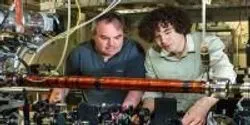Physics

The Large Hadron Collider (LHC) started delivering physics data on June 3 for the first time in 27 months.

Physicists at the University of Washington have conducted the most precise and controlled measurements yet of the interaction between the atoms and molecules that comprise air and the type of carbon surface used in battery electrodes and air filters — key information for improving those technologies.

Putting a hole in the center of the donut—a mid-nineteenth-century invention—allows the deep-fried pastry to cook evenly, inside and out. As it turns out, the hole in the center of the donut also holds answers for a type of more efficient and reliable quantum information teleportation, a critical goal for quantum information science.

Astronomers using NASA's Hubble Space Telescope have uncovered surprising new clues about a hefty, rapidly aging star whose behavior has never been seen before in our Milky Way galaxy. In fact, the star is so weird that astronomers have nicknamed it "Nasty 1," a play on its catalog name of NaSt1. The star may represent a brief transitory stage in the evolution of extremely massive stars.

Quantum computers are in theory capable of simulating the interactions of molecules at a level of detail far beyond the capabilities of even the largest supercomputers today. Such simulations could revolutionize chemistry, biology and materials science, but the development of quantum computers has been limited by the ability to increase the number of quantum bits, or qubits, that encode, store and access large amounts of data.

Data collected on Mars by NASA’s Curiosity rover and analyzed by University of Arkansas researchers indicate that water, in the form of brine, may exist under certain conditions on the planet’s surface.

A team of highly determined high school students discovered a never-before-seen pulsar by painstakingly analyzing data from the National Science Foundation’s (NSF) Robert C. Byrd Green Bank Telescope (GBT). Further observations by astronomers using the GBT revealed that this pulsar has the widest orbit of any around a neutron star and is part of only a handful of double neutron star systems.













